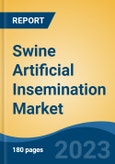Speak directly to the analyst to clarify any post sales queries you may have.
10% Free customizationThis report comes with 10% free customization, enabling you to add data that meets your specific business needs.
Key Market Drivers
Rising Demand for Pork and Pork Products
The global demand for pork and pork products is one of the primary drivers fueling the growth of the Swine Artificial Insemination (AI) Market. As consumer preferences shift towards high-quality meat and the global population continues to grow, the swine industry faces increased pressure to enhance efficiency, improve genetic traits, and maximize pork production. This growing demand directly influences the adoption of AI technologies, which helps expand the market.Pork is one of the most widely consumed meats, particularly in markets like China, the European Union, the United States, and Southeast Asia. It accounts for 36% of global meat consumption, reflecting its culinary versatility, flavor profile, and cultural importance across many regions. Current pork consumption is estimated at 112.6 kilotons, with projections indicating a rise to 129 kilotons by 2031. This growing demand is driven by factors like population expansion, economic prosperity, and changing consumer preferences.
In line with these trends, the global middle-class population is expected to expand by 700 million by 2030, surpassing 50% of the world’s total population. This shift will further fuel the demand for premium pork products and protein-rich diets. As disposable incomes rise, consumers are increasingly willing to invest in high-quality pork, such as organic, processed, and specialty cuts. To meet these demands, pork producers are turning to genetic improvement programs and AI technologies to ensure the production of leaner, healthier, and higher-quality pork.
High Per Capita Pork Consumption
- Hong Kong leads globally with 55.24 kg of pork consumed per capita annually.
- Poland follows with 54.95 kg, highlighting pork’s integral role in both nations' cuisine, particularly in traditional dishes like Golonka in Poland.
Key Market Challenges
Semen Quality Maintenance
Maintaining semen quality is a critical challenge in artificial insemination. Factors such as temperature fluctuations, improper handling, and transportation delays can all negatively impact semen viability, leading to insemination failures. To ensure successful breeding outcomes, advanced technologies and careful handling procedures are required to preserve semen quality and minimize failure risks.Key Market Trends
Precision Breeding and Genomic Selection
A significant trend in the Swine Artificial Insemination Market is the rise of precision breeding. Advances in genomics have enabled breeders to select specific genes associated with desirable traits such as meat quality, disease resistance, and reproductive performance. This allows for more targeted and precise genetic improvements, resulting in healthier and higher-quality swine herds that are better suited to meet both consumer demands and industry requirements. Genomic selection improves overall breeding efficiency and helps optimize pork production, making it a cornerstone of the industry.Key Market Players
- Genus plc
- IMV Technologies SADIR
- Shipley Swine Genetics
- Agtech Inc
- Neogen Corp
- Genpro Inc
- Minitüb GmbH
- Swine Genetics International
- Hypor BV
- Semen Cardona
Report Scope:
In this report, the Global Swine Artificial Insemination Market has been segmented into the following categories, in addition to the industry trends which have also been detailed below:Swine Artificial Insemination Market, By Product:
- Equipment
- Semen
- Reagent
- Kit
- Service
Swine Artificial Insemination Market, By Distribution Channel:
- Private
- Public
Swine Artificial Insemination Market, By End User:
- Hospitals
- Clinics
- Others
Swine Artificial Insemination Market, By Region:
- North America
- United States
- Canada
- Mexico
- Europe
- Germany
- United Kingdom
- France
- Italy
- Spain
- Asia-Pacific
- China
- Japan
- India
- Australia
- South Korea
- South America
- Brazil
- Argentina
- Colombia
- Middle East & Africa
- South Africa
- Saudi Arabia
- UAE
Competitive Landscape
Company Profiles: Detailed analysis of the major companies present in the Global Swine Artificial Insemination Market.Available Customizations:
With the given market data, the publisher offers customizations according to a company's specific needs. The following customization options are available for the report.Company Information
- Detailed analysis and profiling of additional market players (up to five).
This product will be delivered within 1-3 business days.
Table of Contents
Companies Mentioned
- Genus plc
- IMV Technologies SADIR
- Shipley Swine Genetics
- Agtech Inc
- Neogen Corp
- Genpro Inc
- Minitüb GmbH
- Swine Genetics International
- Hypor BV
- Semen Cardona
Table Information
| Report Attribute | Details |
|---|---|
| No. of Pages | 185 |
| Published | February 2025 |
| Forecast Period | 2024 - 2030 |
| Estimated Market Value ( USD | $ 2.1 Billion |
| Forecasted Market Value ( USD | $ 3.03 Billion |
| Compound Annual Growth Rate | 6.4% |
| Regions Covered | Global |
| No. of Companies Mentioned | 10 |









